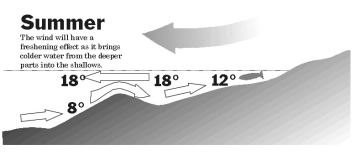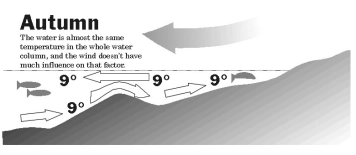The wind is an important factor whan fishing the Danish coastline.
The wind has a strong influence on the behavior of the water, its temperature and the activity of food organisms and trout. The following illustrations all show the situation when a wind is blowing off shore in the four seasons, and show how water will be moved and affect the temperature.
Onshore wind
On shore wind will rarely have the same influence as offshore wind because the wind will only stir the near shore water and not move it very much. Stronger wind might move in surface water from further out towards the coast, but as this surface water will often be the same temperature as the near shore surface water, the overall effect on temperature is relatively small.
But... and there's a big but, onshore wind will stir the shallow water and bring lots of food and debris in suspension. This makes the water unclear and full of food and can mean ideal conditions for hunting fish.
Most fishers will prefer offshore winds which normally means wind in the back, but some people routinely choose onshore wind - and catch a lot of fish.
The seasons
Winter
means cold weather and cold water. As the air will mostly be colder than the water (i.e. freezing) the surface
water will be cloder than the bottom water. Also water is heavier at 4 deg. Centigrade than it is at the freezin point
(0 deg. Centigrade) and hence the warmer water will sink. Wind from the shore will blow away the colder surface water
and bring in warmer water from the deeper parts, and the fish will follow.
But please notice that the shallow water will warm up on sunny early spring days which makes it warmer than
the deep water. On these days a light on shore wind or no wind at all will mean better fishing.
Conclusion: A light off shore wind is generally best in the winter.
In the spring
the near shore water will heat up due to sunshine and warmer air.
This water will attract trout that will feed in shallow areas. If the wind blows away from the shore,
the newly warmed water will blow out and colder water from the deeper parts of the sea will be drawn in.
As long as the shallow water is warmer, the food organisms will be active and attract trout.
When temperatures fall, activity halts and the trout will move. In the early spring when the temperaturs are really low, temperature drops can also mean that the fish will have problems with its osmotic regulation.
Conclusion: Light on shore wind is generally best in the spring.
In the summer
the water can get so hot that the trout will be having problems living in it. On the
other hand, the high temperatures can mean that a lot of food organisms will be moving, and tht creates
an attraction for the fish. Wind blowing off shore will sweep out the warm surface water and draw in colder water
from the deep. This replenishes the water for the trout, but does not disturb the food organisms,
and the trout will follow the colder water in. Current not related to the wind can have the same effect.
Conclusion: Off shore wind is generally best in the summer.
In the autumn
the water temperature will be almost the same near the shore and in deeper parts.
This means the the fish will able to move independent of the wind.
In the autumn the trout are already on the move to the spawning streams or brackish fjords
and the constant temperatures thorughout the water mass makes this even
easier. Fish will move everywhere.
Conclusion: The wind direction in relation to the shore is less important in the fall
Centigrade/Farenheit
The temperatures in the drawings are in degrees Celcius (Centigrade) and correspond to Farenheit almost as follows:
- -18 Deg.C = 0 Deg.F
- -10 Deg.C = 14 Deg.F
- -1 Deg.C = 30 Deg.F
- 0 Deg.C = 32 Deg.F
- 1 Deg.C = 34 Deg.F
- 5 Deg.C = 41 Deg.F
- 10 Deg.C = 50 Deg.F
- 15 Deg.C = 59 Deg.F
- 20 Deg.C = 68 Deg.F
- 25 Deg.C = 77 Deg.F
- 30 Deg.C = 86 Deg.F
- 38 Deg.C = 100 Deg.F
The formula for converting between the two is
Deg.F = (9/5 * Deg.C) + 32
or
Deg.C = (5/9 * (Deg.F - 32))
The optimum temperature for trout is between 9 and 12 degrees Centigrade.
- Log in to post comments











